
常會有找出陣列中是否包含某元素的需求,過去會使用 Array.prototype.indexOf() 來處理,但在 ES2016 (ES7) 提供了 Array.prototype.includes() 新的 Array method,更方便好用,那這兩個差在哪?解決過去的哪些問題?讓我們從 ECMAScript spec 中一探究竟吧。
本文同步發表於 Titangene Blog:JavaScript 之旅 (2):Array.prototype.includes()
「JavaScript 之旅」系列文章發文於:
Array.prototype.indexOf()若要確定陣列內是否包含某元素,過去常見的作法是使用 Array.prototype.indexOf(),你應該有看過這幾種寫法:
let array = ['JS', 'ECMA', 'TC39'];
let searchElement = 'ECMA';
console.log(array.indexOf(searchElement) !== -1); // true
console.log(array.indexOf(searchElement) >= 0); // true
if (~array.indexOf(searchElement)) {
console.log('找到啦!'); // 找到啦!
} else {
console.log('找不到 QQ');
}
利用 Array.prototype.indexOf() 回傳的 index 來確定陣列內是否包含該元素:
-1 代表陣列內沒有該元素但這些寫法有一些問題:
Array.prototype.indexOf() 來問該元素在陣列中第一次被找到的 index 為何,然後使用比較運算子 (即 ===、>= 等) 或位元運算子 (即 ~ ) 來確定該元素是否存在!== -1,有些人會用 >= 0 ... 等,但明明都是一樣的行為NaN:因為 Array.prototype.indexOf() 是用嚴格相等來比較,而 NaN !== NaN ( NaN 本來就不等於自己),所以你無法在陣列中找出 NaN
console.log([NaN].indexOf(NaN) !== -1); // false
Array.prototype.includes()於是在 ES2016 (ES7) 提供了 Array.prototype.includes() 新的 Array method,不用管陣列的 index,直接就會回傳是否包含該元素的 Boolean 值,true 代表包含,false 則代表不包含,非常直覺又方便:
let array = ['JS', 'ECMA', 'TC39'];
let searchElement = 'ECMA';
console.log(array.includes(searchElement)); // true
而且也可以解決 NaN 的問題:
console.log([NaN].includes(NaN)); // true
後面會解釋
Array.prototype.includes()是如何解決NaN的問題,spec 其實都有告訴你!
另外為了一致性,Array.prototype.includes() 的參數用法跟 Array.prototype.indexOf() 的一樣,下面是他們的語法:
Array.prototype.indexOf(searchElement[, fromIndex])
Array.prototype.includes(searchElement[, fromIndex])
註:
[, fromIndex]中的[]不是代表陣列,在語法表示法中代表的是可選參數,而Array.prototype.includes()和Array.prototype.indexOf()的可選參數fromIndex預設為0,代表會從陣列的最前面開始尋找符合的元素。
兩者實際使用的行為一樣 (除了剛剛提到的 NaN 之外):
let array = ['JS', 'ECMA', 'TC39', 'JS', 'ECMA'];
let searchElement = 'JS';
console.log(array.indexOf(searchElement, 2) !== -1); // true
console.log(array.includes(searchElement, 2)); // true
關於為什麼
includes()要命名成includes,而不是has或contains,可參閱 tc39/Array.prototype.includes 的 FAQ。
Array.prototype.indexOf() 的 spec 定義先來看看 Array.prototype.indexOf() 在 spec 的定義:
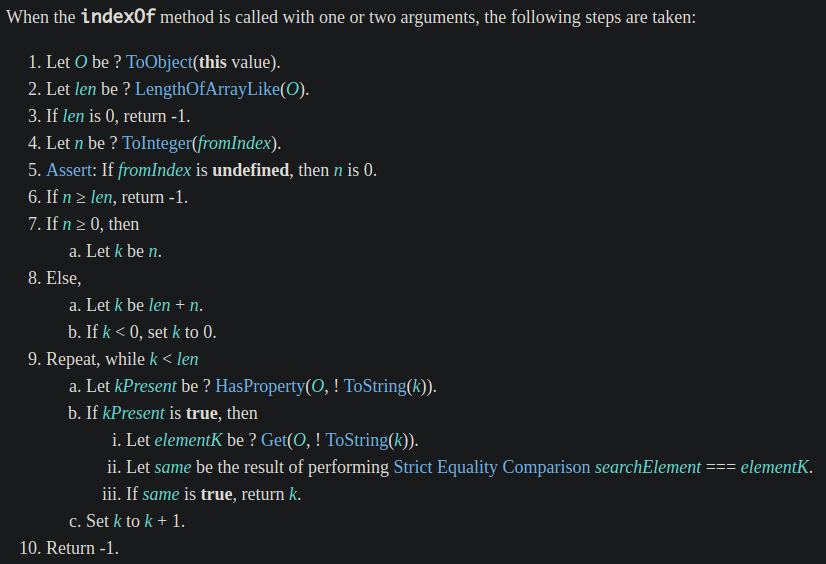
大致上就是從陣列中找出與 searchElement match 的元素,用嚴格相等比較 (Strict Equality Comparison) 來確認 searchElement 是否與陣列中的某元素相同。
在 spec 定義的 1~6 步驟明確說明,何時才會真正開始從陣列中尋找 match 的元素,在某些條件下會直接回傳
-1,例如:陣列的 length 等於 0,或是fromIndex的值大於陣列的 length 的時候。
Array.prototype.includes() 的 spec 定義接著來看 Array.prototype.includes() 在 spec 的定義:
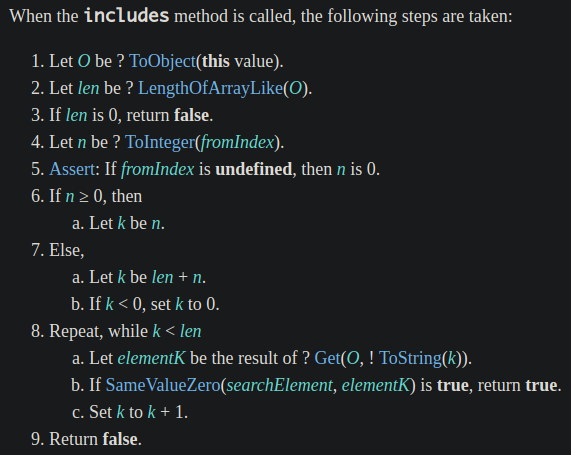
大致上的定義和 Array.prototype.indexOf() 非常像,但有一些不同:
searchElement 是否 match 陣列中的元素時,使用的是 SameValueZero 演算法,而不是嚴格相等比較
NaN 元素undefined (所以 Array.prototype.indexOf() 會跳過 empty slot,因為它在 spec 定義的步驟 9.a,只要沒有該 property 就會直接跳過,繼續比對下一個元素)let array = Array(3);
console.log(array); // [empty × 3]
console.log(array.indexOf() !== -1); // false
console.log(array.includes()); // true
console.log(array.indexOf(undefined) !== -1); // false
console.log(array.includes(undefined)); // true
看完 Array.prototype.indexOf() 和 Array.prototype.includes() 的定義之後,讓我們更深入看前者使用的嚴格相等比較 (Strict Equality Comparison) 和後者使用的 SameValueZero 演算法在 spec 中是如何定義的。
先來看 Array.prototype.indexOf() 使用的嚴格相等比較 (Strict Equality Comparison) 在 spec 的定義:

嚴格相等比較會先比較型別是否相同,不同就回傳 false。
然後,如果型別是 Number 或 BigInt 就會直接進行值的比較。Number::equal 的定義如下:

在步驟 1 和 2 提到,只要值是
NaN就會回傳false,這就是NaN不等於NaN的原因
回到嚴格相等比較的步驟 3:否則,其他型別會使用 SameValueNonNumeric 演算法,spec 的定義如下:
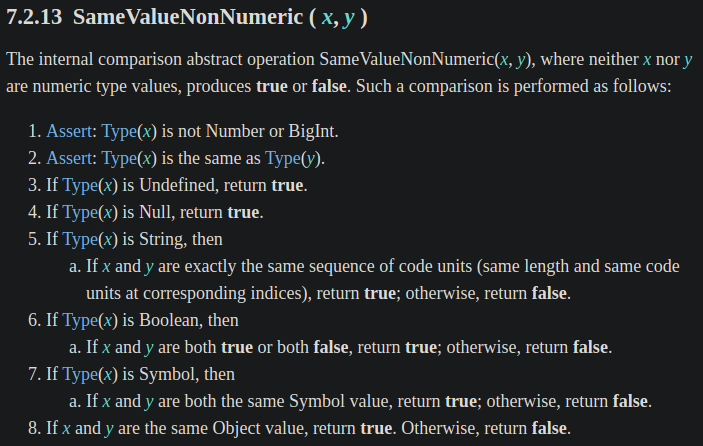
null 或 undefined 時會回傳 true
String 型別就比對字串Boolean、Symbol 和 Object 型別都是比較值是否相同 (但 Object 型別的值必須是同一個參考)如果元素的型別為 Object,值看起來相同,但參考不同時,Array.prototype.indexOf() 和 Array.prototype.includes() 都會找不到一樣的元素 (ECMAScript 表示:啊就真的不一樣啊):
let array = [{id: 1}, {id: 2}, {id: 3}];
console.log(array.indexOf({id: 2}) !== -1); // false
console.log(array.includes({id: 2})); // false
如果是同一個物件參考,就會找到 match 的元素:
let item = {id: 2};
let array = [{id: 1}, item, {id: 3}];
console.log(array.indexOf(item) !== -1); // true
console.log(array.includes(item)); // true
接著來看 Array.prototype.includes() 使用的 SameValueZero 演算法在 spec 的定義:
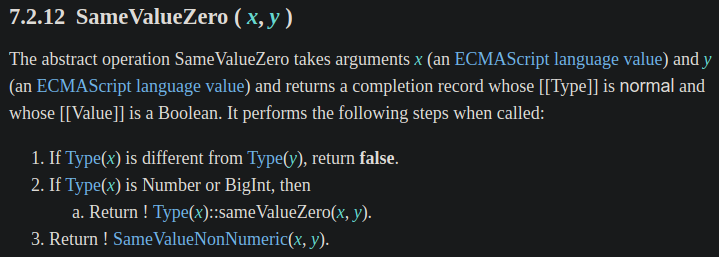
步驟 1 和嚴格相等比較一樣,會先比較型別是否相同,不同就回傳 false。
然後,如果型別是 Number 或 BigInt 就會進行 Type(x)::sameValueZero(x, y) 來比較。那 Type(x)::sameValueZero(x, y) 是啥?其實在 spec 內定義,Number 或 BigInt 型別都是 ECMAScript 內建的 Numeric 型別,而每種內建型別會定義很多 operations,其中的就是 T::sameValueZero(x, y):
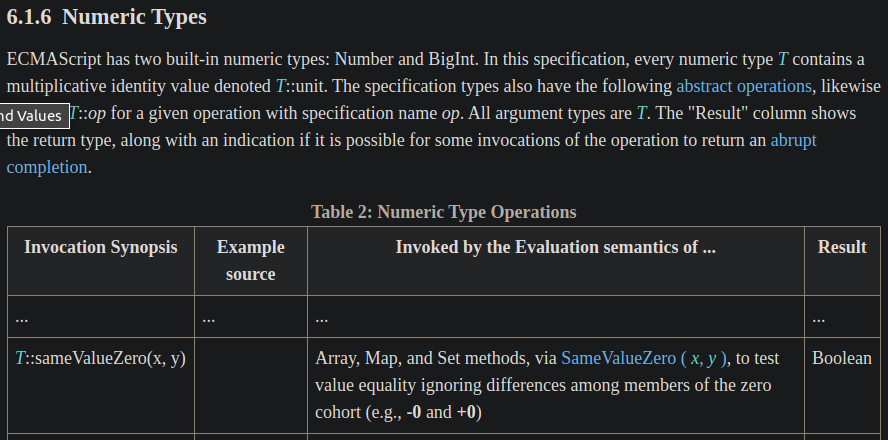
註:因為表格有太多內容了,所以我把這次不會提到的內容都變成
...了。
接著往下找就會看到詳細的定義:

在步驟 1 提到,只要兩個比較的值都是
NaN,就會回傳true,這就是Array.prototype.includes()解決NaN不等於NaN這個問題的步驟。
回到嚴格相等比較的步驟 3:否則,使用 SameValueNonNumeric 演算法,因為上面提到了,就不重複說明囉。
下面是 MDN 提供的 polyfill,若跟 spec 相比可以發現簡化一些東西,但大致上的結果會相同:
// ref: https://developer.mozilla.org/zh-TW/docs/Web/JavaScript/Reference/Global_Objects/Array/includes#Polyfill
if (!Array.prototype.includes) {
Object.defineProperty(Array.prototype, 'includes', {
value: function(searchElement, fromIndex) {
if (this == null) {
throw new TypeError('"this" is null or not defined');
}
// 1. Let O be ? ToObject(this value).
var o = Object(this);
// 2. Let len be ? LengthOfArrayLike(O)
// 即 Let len be ? ToLength(? Get(O, "length")).
var len = o.length >>> 0;
// 3. If len is 0, return false.
if (len === 0) return false;
// 4. Let n be ? ToInteger(fromIndex).
// 5. Assert: If fromIndex is undefined, this n is 0.
var n = fromIndex | 0;
// 6. If n >= 0, then
// a. Let k be n.
// 7. Else n < 0,
// a. Let k be len + n.
// b. If k < 0, set k to 0.
var k = Math.max(n >= 0 ? n : len - Math.abs(n), 0);
function sameValueZero(x, y) {
return (
x === y || (
typeof x === 'number' && typeof y === 'number' &&
isNaN(x) && isNaN(y)
)
);
}
// 8. Repeat, while k < len
while (k < len) {
// a. Let elementK be the result of ? Get(O, ! ToString(k)).
// b. If SameValueZero(searchElement, elementK) is true, return true.
if (sameValueZero(o[k], searchElement)) return true;
// c. Set k to k + 1.
k++;
}
// 9. Return false
return false;
}
});
}
其他 polyfill:
Array.prototype.includes(searchElement[, fromIndex]) | ECMAScript 2021 Language Specification
